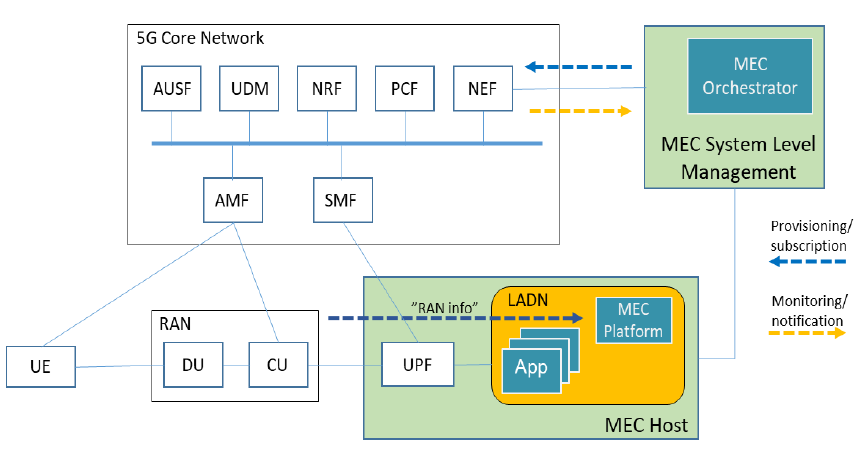MEC多接入边缘计算及关键技术
417 浏览 5 years, 8 months
4.2.5 Capabilities exposure
版权声明: 转载请注明出处 http://www.codingsoho.com/As previously highlighted, there is a specific function, namely the Network Exposure Function (NEF), to expose capability information and services of the 5G CN Network Functions to external entities. Such entities could include Application Functions (AF) such as MEC system functional entities. While 5G Service Based Architecture (SBA) also enables direct access to a Network Function for an authorized AF, there are many cases when services and capabilities are exposed over NEF. Those include the following:
- Monitoring: Allows an external entity to request or subscribe to UE related events of interest. The monitored events include a UE’s roaming status, UE loss of connectivity, UE reachability and location related events (e.g. location of a specific UE, or identification of UEs within a geographical area). The AMF & UDM are the key entities in providing access to such event information.
- Provisioning: Allows an external entity to provision expected UE behaviour to the 5G system, for instance predicted UE movement, or communication characteristics.
- Policy and Charging: Handles QoS and charging policy for UE based requests made by an external party, which also facilitates sponsored data services. The PCF is the key entity with regard to Policy and Charging Control (PCC), although most NFs are involved to some degree in supporting the PCC framework.
Figure 5 illustrates an example of 5G capability exposure to the MEC system. In this case the MEC orchestrator (MEC system level management) appears as a 5G AF, providing centralized functions for managing the computing resources and operation of the MEC hosts. In addition, it offers orchestration of MEC applications running on MEC hosts. The MEC orchestrator as a 5G AF interacts with NEF and with other relevant NFs with regards to overall Monitoring, Provisioning, Policy and Charging capabilities. The MEC host, on the other hand, might be deployed at the edge of 5G RAN to leverage the advantages of MEC for optimizing the performance of applications and improving users’ Quality of Experience. Therefore, it is possible that the MEC platform may need direct exposure to the Centralized Units (CUs) of the 5G RAN and potentially even the Distributed Units (DUs). For example, services offered by a MEC host such as the Radio Network Information Service (RNIS) [5] rely on exposure of the RAN capabilities, especially for the up to date radio information related to UEs. Such information could be used to help MEC applications running on the MEC host to optimize the services offered to those UEs. Directly exposing the radio information, such as received signal received power / quality, to the MEC platform also avoids unnecessary transmission latency and bandwidth consumption of routing messages to its consumers (i.e. MEC applications) via the Core Network. The exposure of local network information is a task of a local NEF instance deployed in the edge.

Figure 5. Capabilities exposure (MEC deployed in Local DN).
The MEC system is also able to leverage network capability information exposed by the 5G RAN to provide add-on services to MEC applications. For example, with access to real-time radio signal measurements, the MEC platform, or even a MEC service producing application, may calculate the precise position of a UE and expose it to MEC service consuming application via the MEC Location Service [6]. Such location information could even be provided back to the 5G network, for instance in relation to the NEF offered provisioning capability with regards to UE location predictions. Information can be used by the 5G system to optimize the service to the end user or be used as part of an overall Location-Based Service (LBS) offering, e.g. UE location-based marketing. This latter example illustrates the versatility of the SBA, where also the MEC functions/applications can produce services for the 5G system.